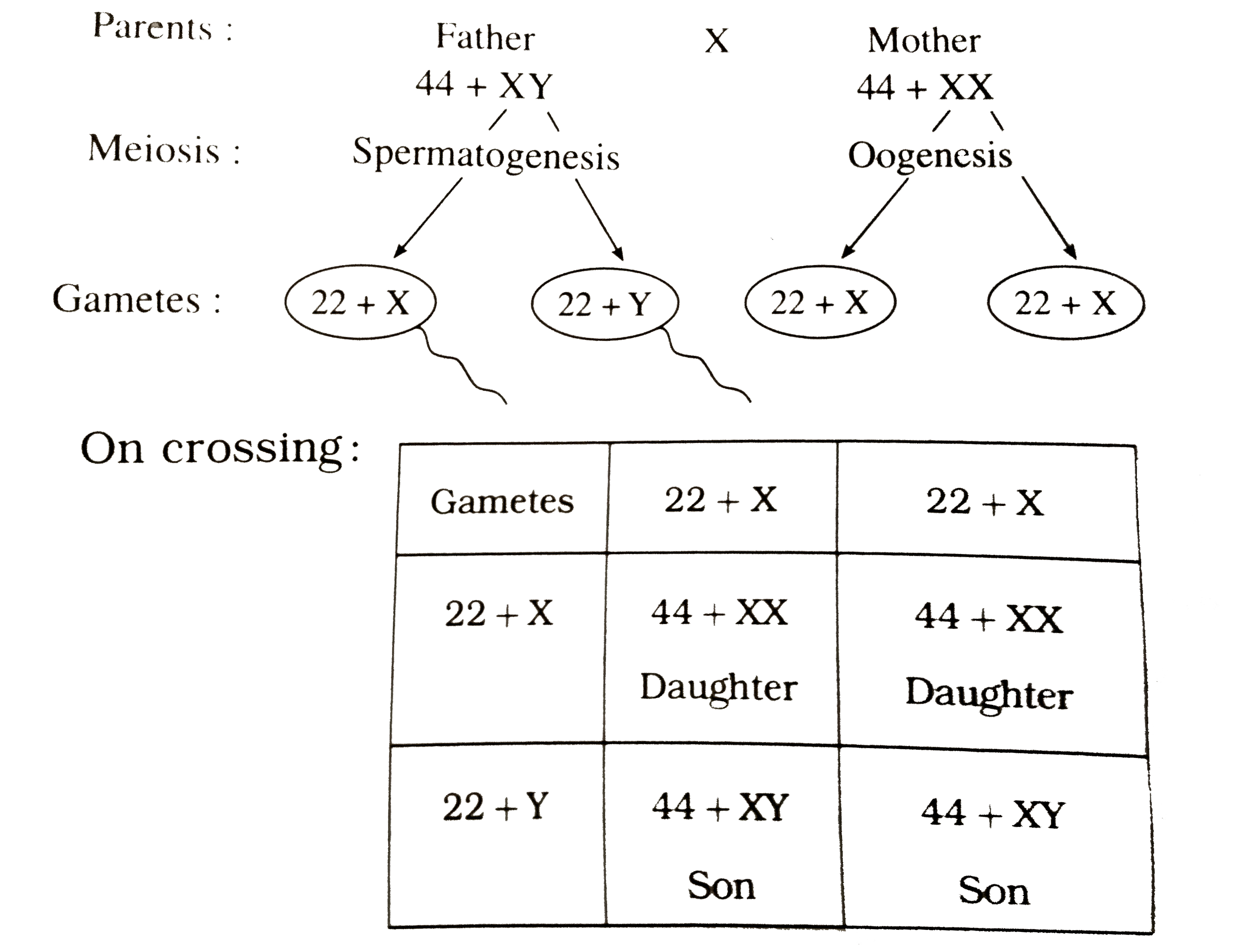Explain the mechanism of sex determination in human being.
Sex determination in human beings :
(1) In human beings, the sex is determined with the help of X- and Y-chromosomes. This chromosomal mechanism of sex determination is of XX-XY type.
(2) In male, the nucleus of each cell contains 46 chromosomes or 23 pairs of chromosomes. Of these 22 pairs are autosomes and one pair of sex chromosomes. Males are thus heteromorphic as they have two different types of sex chromosomes.
(3) Autosomes or somatic chromosomes are responsible for determination of other characters of the body, but not the sex.
(4) In female cells, there are 22 pairs of autosomes and one pair of X-chromosomes. Females are thus homomorphic as they have similar sex chromosomes.
(5) Thus the genotypes off emale and male are as follows :
Female : 46 chromosomes= 44 autosomes + XX sex chromosomes
Male : 46 chromosomes= 44 autosomes + XY sex chromosomes
(6) During gamete formation, the diploid germ cells in the testes and ovaries undergo meiosis to produce haploid gametes (sperms and eggs). The homologous chromosomes separate and enter into different gametes during this process.
(7) The human male produces two different types of sperms, one containing 22 autosomes and one X-chromosome and the other containing 22 autosomes and one Y -chromosome. Human males are therefore called heterogametic, i.e. they produce different types of gametes.
(8) The human female produces only one type of eggs containing 22 autosomes and one X-chromosome and therefore she is homogametic.
(9) During fertilization if X containing sperm fertilizes the egg having X-chromosome then a female child with XX-chromosomes is conceived.
(10) If Y containing sperm fertilizes the egg having X-chromosome then a male child with XY-chromosomes is conceived.
(11) The sex of the child thus depends upon the type of sperm fertilizing the egg. The heterogametic parent determines the sex of the child and thus the father is responsible for the determination of the sex of the child and not the mother.

Topper's Solved these Questions
- SHORT ANSWER QUESTIONS -IIBook:NAVNEET PUBLICATION - MAHARASHTRA BOARDChapter:SHORT ANSWER QUESTIONS -IIExercise:Ch-15 (Circulation)
Explore 4 Videos
- SHORT ANSWER QUESTIONS -IIBook:NAVNEET PUBLICATION - MAHARASHTRA BOARDChapter:SHORT ANSWER QUESTIONS -IIExercise:Ch - 16 (Excretion and Osmoregulation)
Explore 3 Videos
- SHORT ANSWER QUESTIONS -IIBook:NAVNEET PUBLICATION - MAHARASHTRA BOARDChapter:SHORT ANSWER QUESTIONS -IIExercise:Ch - 10 (Origin and Evolution of Life)
Explore 6 Videos
- SHORT ANSWER QUESTIONS -I Book:NAVNEET PUBLICATION - MAHARASHTRA BOARDChapter:SHORT ANSWER QUESTIONS -I Exercise:Chapter 19 : Organisms and Environment - II
Explore 7 Videos
- SHORT NOTES Book:NAVNEET PUBLICATION - MAHARASHTRA BOARDChapter:SHORT NOTES Exercise:Short notes on
Explore 2 Videos
Similar Questions
Explain the mechanism of sex determination in man.
View SolutionExplain the mechanism of sex determination in humans with suitable chart.
View SolutionExplain the mechanism of sex-determination in humans.
b) Differentiate between male heterogamety and female heterogamety with the help of an example of each.
View SolutionExplain the mechanism of Sex-determination in birds.
View SolutionExplain the method of sex determination in humans.
View SolutionIn humans, there is a 50% probability of the birth of a boy and 50% probability that a girl will be born. Justify the statement on the basis of the mechanism of sex-determination in human beings.
View SolutionExplain the mechanism of Sex-determination in birds.
View SolutionExaplain the mechanism of sex determination in birds. How does it differ from that of human beings ?
View SolutionExplain the mechanism of sex determination in insects like Drosophila and grasshopper.
View SolutionExplain the mechanism of sex determination in insects like Drosophila and grasshopper.
View Solution

